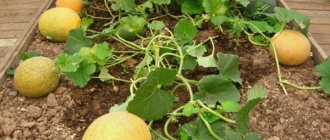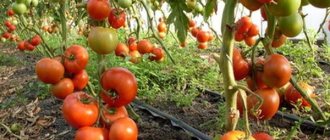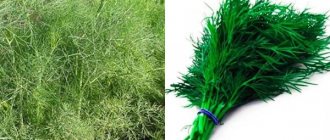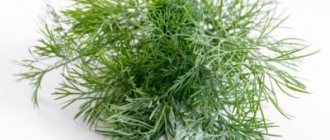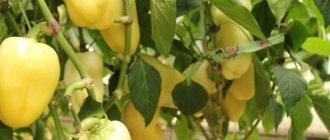Among the huge variety of types of sweet peppers, the Ox's Ear variety occupies a special place. It has excellent taste, attractive appearance, and can be transported over long distances. Ease of cultivation and care makes this variety the most popular among summer residents.
Pepper Ox's ear
Ox's Ear Pepper Seeds
Pepper bush Ox ear
Characteristics and description
This variety is so popular among gardeners due to the universal purpose of the fruits and the ease of caring for and growing bushes. The pepper got its name due to the interesting shape of the fruit.
Description of the bush
The bush is quite spreading, so its appearance resembles a large head. It can reach a height of 60-65 cm. Drooping fruits are formed; peppers may have a base slightly set to the side.
The leaf blade can be medium or very large. The color is dark green or green, there is slight wrinkling.
Description of fruits
The variety is large-fruited. The peppers are quite large, they can even be larger than a human palm. The length of the fruit is no more than 20 cm, weight can vary between 150-200 g.
The fruit has a very interesting shape in the form of a cone with slight bends. From the point of attachment to the stalk and up to the tip, there is a smooth bend of the pepper, the general shape is in the form of a regular cone. On one plant there may be fruits that are regularly shaped and very strongly curved. But most of the fruits have an attractive and smooth curve in the central part.
From the moment the fruits set, curves appear on them. Over time, as the peppers grow, these bends may straighten or take on a more pronounced shape and appear on other parts.
Fruits that are not fully ripe are dark green in color. Over time, the fruits turn red. Having reached full biological maturity, peppers become richly red. A distinctive feature of the variety is its pronounced gloss.
There are 4-5 seed nests inside the fruit, but not too many seeds. The walls of the pepper are about 6 mm thick, but in places of bend it can be thicker or thinner. The fruits have a sweet and pleasant taste, rich aroma and a persistent aftertaste.
Productivity
On average, from 1 sq. m you can collect about 3 kg of fruit. But there are cases when just one plant produces more than 10 peppers, with the average weight of each being approximately 160 g, so more than 1.5 kg of fruit can be collected from one bush. Consequently, the yield also increases - from 1 sq. m almost 5 kg of harvest.
Precocity
To obtain fully ripened fruits, it takes 130 days from the moment the seeds are planted in the ground. The variety is a mid-season variety; harvesting occurs as the fruits ripen.
In central Russia and the north, this variety of sweet pepper can only be grown using seedlings. It is not recommended to sow seeds directly into the ground.
Growing regions
This variety is intended for cultivation in the southern territories of Russia, for example, the Krasnodar Territory.
But even in the northern regions, Ox’s Ear can be planted, but only in greenhouse conditions. It is the greenhouse that will help protect plants from possible frosts. In September, the first cold snap begins, so it is worth additionally closing the entrance to the greenhouse so that the drop in temperature does not negatively affect the harvest.
Typical diseases and pests
Ox's ear is resistant to most common pepper diseases. To minimize the risk of plant infection, they are sprayed with a Fitosporin solution once a week.
Pepper is not protected from insects. There are several folk remedies for pest control:
- To remove aphids, spider mites and other small insects, the bushes are sprayed with a soap-onion solution. To prepare it, add 1 piece of grated laundry soap, 1 onion minced in a meat grinder and 2 small hot peppers to a bucket of water. The remedy is infused for a day. It is also used for prevention.
- To repel slugs, vegetable leaves are sprinkled with tobacco or ash.
- To protect the roots from mole crickets, crushed eggshells are poured into the holes.
Recommendations for cultivation
Planting and growing Ox's Ear peppers does not pose any particular difficulties. But it is the correctness of these stages that determines how good the harvest will be obtained.
Planting seedlings and timing
Taking into account the region where the pepper will be grown, planting dates are determined. In order to transplant mature and strong seedlings into the ground in mid-May, preparations must begin in early March - sowing seeds.
When growing a plant in greenhouse conditions, the seeds are sown in the ground approximately 14-16 days earlier - in mid-February.
Before planting, prepare the seed material:
- Fill the grains with water and remove any that float. Only those seeds that remain at the bottom are suitable for cultivation;
- leave on damp gauze for 2-3 days and moisten periodically, as the seeds should swell;
- to disinfect grains, treat them with a solution of potassium permanganate;
- rinse with warm water.
Algorithm for planting seeds:
- mix the soil for seedlings with the soil in which plants will be grown in the future, thanks to which acclimatization will take place much faster;
- plant 3 grains in one pot filled with soil;
- cover the containers with film;
- place in a warm place where there are no drafts;
- after the first shoots appear, remove the film;
- grow until full bushes appear.
You should not plant seeds in boxes, as peppers do not tolerate the picking procedure due to their weak root system.
Care requirements
To speed up the process of seedlings getting used to a new place, regularly take the plants outside for hardening. Doesn't require too much watering. Moisten the soil as it dries. It is best to use a spray bottle.
Feed the seedlings once every 10-15 days. Use complex mineral fertilizers, which should contain valuable microelements. Before planting seedlings in a permanent place, you can water the plant with Zircon, thanks to which it adapts to the new place much faster. Follow the instructions on the package.
Transplantation into open ground, timing
The ideal time to transplant seedlings into open ground is mid-May. It is very important that warm weather sets in and the threat of return frosts completely passes.
Algorithm for planting seedlings in open ground:
- plant plants taking into account the scheme - 60x50 cm;
- about 30-40 minutes before transplanting, water the plants generously;
- for replanting, take the seedlings together with a lump of earth, which will minimize the risk of injuring the roots;
- make sure that when planting, the root collar is above the ground;
- After planting, water the plants generously.
Features of growing the variety
The bushes of the Ox's Ear are not tall - it is not necessary to tie them up. If, under the weight of the fruits, the bushes begin to bend toward the ground, you will have to attach them to a support.
The formation of a bush is not required: the abundance of fruits is ensured by the spreading nature of the variety.
The leaves at the bottom of the bush are removed. Get rid of yellowed and withered greenery.
Cow's ear is demanding on soil composition. The vegetable is fed at least 3 times per season. Complex mineral and organic fertilizers are used.
The variety is sensitive to temperature changes. In the greenhouse, the room is ventilated and care is taken to ensure that the temperature is not too high. On hot days, install a fan. When it gets cold outside, peppers are covered with film, otherwise they will simply die due to frost.
Care Tips
Experienced gardeners know the secrets of a rich pepper harvest:
- The beds are mulched with rotted hay to protect the roots of the crop from freezing, pests and diseases.
- Water the pepper at least 2 times a week only at the root. Before flowering, the bushes are sprayed with warm water.
- To attract pollinating insects during flowering, the beds are sprayed with sweet water (1 tbsp. sugar per bucket of water). Add 1 tbsp to the mixture. l. boric acid for rapid formation of ovaries.
We should also talk about fertilizers, for which there are plenty of recipes:
- The crushed peels of 4 bananas and the shells of 6 eggs are infused in 6 liters of water for 3 days. The mixture is used for the first feeding. For each plant take 1 liter of fertilizer.
- Add 8 tbsp to 4 liters of hot water. l. ash, leave for a day. Water the peppers when fruit sets.
- Chopped chamomile, plantain, and nettle are poured into a bucket. The total mass of greens should occupy half the container. The rest of the volume is filled with ice water. This “tea” is steeped for a week. Then dilute with water in a ratio of 1:10. Water once every 7–10 days, 3-4 liters per 1 m2.
- For every 5 liters of water, take 0.5 kg of chicken manure and leave for 5 days. 1 liter of fertilizer is poured under each bush during the flowering period.
Outdoor care requirements
To obtain a rich harvest of tasty and aromatic peppers, you need to properly and regularly care for the plants. Watering, fertilizing and protecting the bushes from the scorching sun is important.
Watering
It is important to water the plants frequently; the soil should not be allowed to dry out too much. The interval between waterings should not be more than 2 days, but in extreme heat, the procedure can be carried out more often. The ideal option would be to use a drip irrigation system.
The mulching procedure (hay, straw, peat) will help retain moisture in the soil. This will increase the intervals between waterings and solve the weed problem.
Formation
There is no need for pinching and bush formation. But at the end of summer it is worth removing small ovaries and flowers, as they will not have time to fully ripen. As a result, the ripening of larger peppers slows down, because new ovaries begin to absorb part of the nutrition.
Feeding
The variety requires the application of complex mineral fertilizers. It is better to purchase them in advance and add them in balanced doses, according to the instructions indicated on the package.
Sun protection
If it is very hot, the fruits and foliage of the plant are depressed. Burns appear on the plant and the yield decreases. In such situations, it is necessary to additionally shade the pepper using mesh or spunbond. The bushes are not very tall, so you can install arches in the spring, on which a net is placed in the heat.
How to properly plant seedlings in a permanent place
Good and healthy seedlings are just one of the stages of growing any crop. To no less an extent, the final result of the work is influenced by how well the time and place for planting pepper was chosen, as well as how this procedure itself was carried out.
Find out why peppers bloom and set poorly.
Deadlines
It is, of course, very difficult to accurately determine the date of planting Ox Ear seedlings in a permanent place, but the ideal to which one must strive should presuppose a combination of the following conditions:
| Age of seedlings (in days from the appearance of the first shoots) | 50–60 |
| Seedling height, cm | 18–20 |
| Stem thickness, cm | 0,4–0,5 |
| Number of true leaves | 79 |
| Vegetation phase | laying the first buds (flowering should not begin) |
| Average daily air temperature | +15…+17°С |
| Soil temperature at the depth of the root system (minimum 10 cm) | +10…+12°С |
Choosing a location on the site
It is best to choose a bed for sweet peppers on the south side. This crop needs a lot of heat and light and does not tolerate strong winds. If the groundwater lies very close to the surface of the earth, it is useful for the Ox Ear to build a high bed. This technique will protect the root system of the plant from stagnant water and provide the above-ground part of the bush with better lighting and heating. Ox's ear will feel best on loam or sandstone enriched with humus and nutrients.
The culture prefers a neutral acidity level (pH in the range of 6–6.8). Pepper grows very poorly on acidic and heavy clay soils, so if necessary, at the stage of preparing the bed, components that reduce acidity and increase friability, for example, chalk and sand, must be added to the soil. One of the secrets to success when growing any crop is the successful choice of predecessors and neighbors.
Read more about how to speed up the ripening process of peppers.
When it comes to sweet peppers, you must follow these rules:
| Good predecessors |
|
| Bad Predecessors |
|
| Good neighbors |
|
| Bad neighbors |
|
It is undesirable to plant plants from the same family in one place for more than one year: on the one hand, this increases the risk of the crop being damaged by pathogenic microorganisms and pests that have successfully overwintered in the garden bed, including in plant debris; on the other hand, the soil is greatly depleted, losing exactly those substances that are most needed by this particular culture.
Planting pattern and depth
Cow's ear needs a significant amount of free space, which should be provided to each plant. Based on this, the creators recommend using a 50×70 cm pattern when planting this type of pepper. Having marked the future bed, it is necessary to dig holes, the depth of which should ensure free placement of the entire earthen coma of the seedling bush in it, while it is necessary that the root collar of the plant placed in the hole, after it was buried, turned out to be strictly at the level of the ground surface.
Features of care in a greenhouse
Caring for bushes grown in a greenhouse is the same as in open ground:
- for watering, use only warm water;
- fertilize regularly;
- ventilate the greenhouse periodically;
- During flowering and fruiting, water exclusively at the root.
Reviews
Despite the fact that the variety is demanding of care, it pleases with high yields and excellent taste of the fruit. Gardeners respond mostly positively to the variety.
Victoria, Voronezh: “I have been growing ox ear for several years now. This variety has crowded out all other peppers from my garden. Its fruits are huge and bright, as in the photo. The walls are thick and fleshy, the taste is sweet. It makes the most delicious lecho. Of course, you will have to tinker with cultivation. To prevent plants from dying, it is important to fertilize regularly. You won’t be able to grow it at the dacha where you go on weekends.”
Igor, Ryazan: “I tried to grow Ox Heart for the first time 3 years ago. I planted it in open ground early, and all the plants died. For a long time I didn’t dare try this variety again, but the desire to have fruits in the garden, like at the market, won out. Last year everything worked out. True, I grew it under film. It is necessary to mulch the soil, preferably with humus. I fed the plants only with silage with the addition of superphosphate.”
Advantages and disadvantages of the variety
The main advantages of the described variety are the following qualities:
- pleasant and bright taste;
- excellent transportability allows transportation over long distances;
- can be consumed fresh and used for processing;
- fruits ripen early;
- big harvest;
- resistance to various diseases and pest attacks;
- can be stored for a long time.
The disadvantages of the variety are:
- low frost resistance in spring during frosts;
- the need for abundant access to sunlight;
- intolerance in the greenhouse to temperatures above 30-32 degrees, flowering and ovaries begin to fall off.
Growing peppers from seeds
You need to buy and sow seeds for seedlings in the 3-4th week of February. Do you live “in the south”? In this case, do not rush: the seeds are sown in open ground at the end of May. The ground temperature should approach 20 degrees (at night the ground may cool slightly, but not be lower than 15 degrees).
When calculating the number of future seedlings, remember: if the seeds are collected in your own garden bed and are fresh, the germination rate can be 100%. But with purchased seeds everything is not so good; their germination rate is often about 50%. Take this into account when purchasing seed.
Seedlings are grown like this:
- Cover the seeds with water. Throw away everything that comes up - this is a defect that will not germinate. The remaining seeds can be left in water for 1-2 days.
- Now briefly soak the seeds in a solution of potassium permanganate or aloe juice - this is disinfection. After this, they should be washed with warm water.
- Fill the boxes with soil from your garden (the same soil in which the adult peppers will later grow). It should be fluffed up a little by adding sand, and also fertilized with ash. If you are currently in the city, and your garden is located in the village, you can buy ordinary universal soil.
- “Seal” the top of the box with a piece of film, keep the seeds at 25 degrees.
- When the seedlings grow 2-4 true leaves, they should be planted in separate containers. She does not tolerate this procedure very well, so be extremely careful and use only the transshipment method. In addition, after replanting, the plants can be watered with a rooting solution.
To avoid picking altogether, you can immediately use individual containers. Plant 3 seeds here. After waiting for a bunch of real leaves, sort out the seedlings, leaving the strongest sprouts and pinch off the weak ones.
Caring for growing seedlings is simple: protect them from direct sunlight and the formation of condensation on the leaves, water with lukewarm water.
Planting seedlings in open ground or greenhouse
Shortly before planting in the ground, harden the young peppers by placing them outside, on the veranda or on the balcony for a short time every day.
Bad predecessors for peppers: potatoes and tomatoes (these “guys” eat up the soil so much that the poor pepper has nothing left in it). If you have no choice and you have to grow Ox’s Ear immediately after tomatoes, at least generously fertilize the soil with organic matter in the fall. Good predecessors: turnips, cabbage, cucumbers, legumes, and green manure crops.
Important! Do not grow tomatoes or potatoes next to sweet peppers. In addition, do not plant hot (bitter) peppers in the same bed. The crops will be cross-pollinated, and as a result, the fruits of all bushes will turn out to be sharply bitter.
Time to plant in the garden: late May - early June. Such bushes will begin to bear fruit from the last week of July, and if it’s a little cold here, then in early August.
When planting, add compost or humus to each hole.
Caring for a fruiting plant
- Illumination. The more light and warmth the Ox Ear receives, the better. However, it will be good if there is something tall nearby (for example, corn), which will protect the bushes from the hot midday sun. At the same time, this culture does not like musty air. If you grow peppers in a greenhouse/greenhouse, air them often, otherwise the bushes will begin to drop their buds.
- Watering. Use only warm water. We pump it from a well, so first we fill a large vat, which is heated in the sun all day, and in the evening we distribute the water with a watering can. You need to water the Ox's Ear about 2 times a week (if it's very hot outside, then more often). Important! While the seedlings are not blooming, you can water the bushes using a watering can with a diffuser (“rain”). As soon as the flowers appear, the diffuser must be unscrewed, directing the water stream directly under the stem. One bush drinks about 1.5 liters at a time.
- "Manual therapy". Like any other crop, pepper needs weed removal and soil loosening. Or you can go the other way: even when planting, mulch the bed, and stop there.
- Feeding. Pepper is suitable for both organic matter (especially slurry or chicken droppings) and mineral compounds. Superphosphate has also proven itself well. It is worth feeding the pepper three times: 2 weeks after planting the seedlings, at the beginning of flowering and when the peppers begin to turn red.
- Pests. Colorado beetles, slugs, spider mites and aphids enjoy ox ear. Moreover, these scoundrels attack more often when the peppers have already started and it is impossible to spray them with anything purchased. We will have to use “traditional medicine”. Colorados can be driven away with celandine tincture, against slugs, all bushes can be covered with tobacco dust (plus the soil between them with mustard), and spider mites are afraid of soap solution, as well as onion or garlic tincture.
There are many tricks to growing peppers. And there are often repeated mistakes, due to which even the best varieties bear fruit very poorly. This video will help prevent them:
https://youtube.com/watch?v=Mu9-bE7Akn0
Reviews from gardeners
Before purchasing and germinating these seeds, I heard a lot about them. Neighbors said that Ox's Ear is a good-yielding variety that consistently produces generously in the garden, or even better, in the greenhouse. It's a great option for salads and super sweet.
If you don’t pick the fruits when they just turn red, but let them grow a little, they will increase in size even more and become juicier. The largest peppers on the bushes are those that set first. Then they will grow smaller and smaller in size. And the latest, September fruits, due to their small size, are used for stuffing.
Having received the first harvest, I realized that I will grow the variety next year too!
Here's what I liked:
- when harvesting it is very convenient to clean, there are almost no seeds or partitions inside;
- if you hurry and pick slightly unripe fruits, they will still not taste bitter;
- The pepper harvest is very rich, the bushes are simply covered with fruits;
- if I don’t have time for care (frequent watering, fertilizing), the harvest still turns out good;
- In all this time, my pepper has never gotten sick.
Having prepared a lot of lecho and other salads, I freeze the remaining peppers. I just remove the seeds, cut them into strips of different thicknesses, put them in special bags, and put them in the freezer. In winter, such pieces go into borscht, sauté or risotto (wide strips), and pizza (narrow strips). I highly recommend this method of preparation!
- Ox's ear is a mid-season variety of sweet pepper. It is valued for its thick, juicy fruit walls, pleasant taste and excellent yield.
- When buying seeds, it is important to find a manufacturer operating in your region. The same variety, but grown in a warm area, will give a weak harvest in Siberia.
- This crop can be grown both in open ground and in a greenhouse.
But you don’t have to grow just one variety, right? I offer a video review of the ten best varieties of sweet peppers. In addition to the Ox's Ear, there are Gogoshary, Lesya and other proven options:
In terms of volume of consumption by the population, sweet peppers are in the top three along with tomatoes and cucumbers, but, in comparison with them, the agricultural technology for growing them is somewhat more complicated. The Ox's Ear pepper, bred by domestic breeders, has an outstanding taste compared to the “glass” imported hybrids. Let's introduce the gardener to this variety, its features and the secrets of agricultural technology.
Reviews of the Ox's Ear variety
★★★★★
Lyubov, 35 years old, entrepreneur, Krasnodar region. This variety was a real find for me.
Even one bush brings an excellent harvest. I purchase seeds from trusted suppliers and am completely satisfied with the results. I like the bright aroma and the fact that peppers can be used both for preparing fresh salads and for canning. ★★★★★
Evgeniy, 40 years old, farmer, Stavropol region. Every year I plant only this variety of pepper.
The fruits are large and very tasty, have a bright aroma. I grow not only for the family, but also for sale. Hide
Add your review
Ox's ear pepper allows you to get a rich harvest of a tasty and aromatic vegetable. The most important thing is that you need to properly care for it - follow the watering schedule, regularly fertilize and remove weeds.
0
0
Copy link
Harvest and storage
Peppers grown from seedlings begin to harvest as early as July. This must be done correctly to increase the shelf life of the fruit.
Despite the thick skin, peppers should be removed carefully so as not to damage the skin. Otherwise, fungal spores may get on the damaged tissue, which will lead to the death of the entire batch of pepper.
The fruits can be picked dark green when they reach the required size. Peppers at technical ripeness are in no way inferior in taste and aroma to biologically ripe fruits.
Thick-walled large-fruited varieties
Wall thickness and fruit size are the deciding factors for most gardeners when choosing seeds. Thick-walled peppers are those with a flesh thickness of 6mm or more. These varieties are great for canning, drying and freezing.
White gold
Pepper variety White gold
Can be planted in open ground. The plant is low, with very large yellow fruits (up to 450g). The peppers are cube-shaped.
Siberian format
Sweet pepper variety Siberian format
Mid-season, very large peppers grow on tall and powerful bushes. The size of a fruit grown in a greenhouse can reach 500 g!
Queen
Sweet pepper Tsarina
Productive, the fruit is small in size (up to 200g) and has thick, ruby-red flesh. Withstands long-term transportation very well.
The best peppers for stuffing and processing
Stuffing
Stuffed bell peppers
The ideal use of peppers in food is stuffing them. For this, smooth, medium-sized peppers of the same size are usually used. Among the early ones we can note: Lyubava, Divo, Golden Miracle, Banana, Marinka's tongue. Among the mid-season ones: Antey, New Russian, Stepashka.
Drying
Long and elongated fruits are suitable for drying. Sabelka and Miracle paprika are perfect for this. You can dry them directly in the fresh air.
Canning
Canned sweet peppers
For preservation, it is ideal to use meaty, thick-walled varieties. And if you take several multi-colored peppers, the preparation will turn out not only tasty, but also beautiful. Perfect for canning: Avangard, Adept, Bogdan, Ideal, Lilac Bell, Chocolate Beauty, Amber.
What other varieties are there?
In fact, there are many varieties of peppers. And it is impossible to present a description of varieties within one article. The most popular hybrid forms were discussed above. However, it should be noted that many summer residents leave good reviews about the Red Miracle, Red Knight, Red Side, Denis, Fidelio, Little Red Riding Hood, Red Bell and Cavalier peppers. Therefore, these varieties for the greenhouse also deserve attention.
Red miracle
Pepper is intended for growing in film-type greenhouses or in an open area. The ripening period ranges from 75 to 80 days. The culture grows up to 80 centimeters. The fruits have a cubic shape. The pulp is juicy and sweet. The pepper is colored red. Vegetable growers note the following advantages of the variety: high yield, excellent taste, simultaneous ripening of fruits, preservation of the harvest.
Red Knight
Having studied all the reviews about the Red Knight pepper, it is worth highlighting its following features. The plant is resistant to a number of diseases and is completely unpretentious to grow. Grows well both in greenhouses and in open ground. The peppers are quite large, bright red in color.
Red side
Good reviews about Red Side pepper are also a decisive factor for many in choosing this variety. The crop gives an early harvest. The fruits are large: about 250 grams. They have a cuboid shape. Their hue is bright red. Red side is resistant to all major diseases characteristic of pepper.
Denis
Denis pepper belongs to the hybrid forms. This is an early variety, ripeness occurs 80 days after the first shoots. The plant grows up to 70 centimeters in height. The fruits taste sweet. Quite large, cuboid. Each specimen weighs about 400 grams. Their color is red. The culture is resistant to tobacco mosaic virus. This variety is suitable for growing in closed or open soil. In greenhouses it usually grows taller and produces a better harvest.
Fidelio
Many summer residents fell in love with Fidelio pepper for the excellent taste characteristics of the fruit and the high resistance of the crop to the tobacco mosaic virus. Fidelio is an early ripening plant. The shrub grows up to 85 centimeters in height. Produces cube-shaped fruits of a silvery-white hue. The weight of each specimen is 175 grams. Typically, gardeners harvest up to 14 kilograms of crop per square meter.
Little Red Riding Hood
Red cap pepper is highly valued for its excellent seed germination, which reaches 92%. The shrub is high-yielding and early ripening. Its height is about 70 centimeters. About 8 fruits are formed on each bush. They are quite large in size and have a cuboid shape. Each pepper weighs from 200 to 250 grams. The taste is very pleasant, sweet. The pulp is juicy. The variety is resistant to low temperatures and poor lighting. Farmers harvest up to 10 kilograms of pepper per square meter.
Red bell
Red bell pepper belongs to a very rare species - berry pepper. The height of the bush is up to 2 meters. Each bush produces up to 2 kilograms of harvest. The fruits weigh from 40 to 75 grams. Sometimes they reach a mass of 100 grams. The taste of the fruit is medium-hot.
Many people use Red Bell as an ornamental plant.
Cavalier
Cavalier pepper is characterized by cone-shaped fruits with a smooth and glossy surface. Their color is red. Each specimen weighs about 80 grams. The taste is pleasant.
Thus, today you can find different varieties of pepper on sale. Their taste, color, and ripening period differ significantly. To choose the appropriate option, you need to understand the most popular varieties and hybrids. The article examined the varieties that are most popular among beginners and professional vegetable growers. Check out the article:
Planting and care
Bogatyr-Pfeffer grows well in sandy, loamy soils with good drainage.
It belongs to mid-season paper varieties and begins to ripen 113-115 days after germination. When to plant?
To grow seedlings, you need to plant pepper seeds in February or early March. Seeds germinate at a temperature of 20-25 C, and seedlings appear no later than 20 days later. It is necessary to ensure that the success of growing this plant depends on the age and quality of the shoots.
It is also necessary to take into account the specifics of methods for growing pepper in agriculture:
- First, the seeds should be drunk and soaked in a solution of light pink manganese for about 20 minutes.
- After washing with water and wrapping with a damp cloth to allow the seeds to swell for 12 hours.
- They should be stored at 25-28°C for about two days.
- Then place the seeds in the previously prepared soil:
- enrich the soil with sand and peat;
- Add a glass of ash, about 35 g of superphosphate, 15 g of potassium sulfate and 15-20 g of ammonium nitrate;
- Cover the seedling box with transparent foil or glass and maintain room temperature between 23-26°C.
The seeds will sprout no later than 20 days. When 1-2 true leaves appear, collect the plants - dilute the seedlings and plant deeper roots.
Don't forget to add fertilizer and pepper:
- fertilized for the first time 14 days after culture transplantation;
- then during pepper ripening;
- one last time before laying him down on the bed.
As weather conditions increase, seedlings harden, i.e. are left outside.
- Paprika seedlings should be planted outdoors at the end of May, but it is better to plant them later than to rush.
- In accordance with the requirements of the agricultural cultivation technology of this association, in the fall the land is prepared for planting seedlings.
Thus, it is fertilized - 65 g of phosphorus and potassium fertilizers per square meter. Peppers should not be grown in place of potatoes or tomatoes.
Planting takes place in special wells, which are prepared and moistened before planting. Bogatyrsky pepper should be planted at a distance of at least 50 cm from each other. When planting shrubs, their root system is isolated from the soil and fertilized with peat to prevent the soil from hardening. It is necessary that moisture penetrates around and under the seedlings to a depth of 20 cm. To do this, it is necessary to carry out rare but abundant irrigation. During fruit ripening, you need more moisture. If you are growing peppers in a greenhouse, consider good ventilation because peppers like cold and moisture. Bell pepper flowers continue until the first frost. For the Bogatyr variety, it is necessary to make a garter so as not to damage the stem. Due to the tenderness of this crop, the fruits are collected very carefully.
Bogatyrpfeffer has a rich composition and has a great impact on human health:
- Pepper, rich in vitamins, strengthens blood vessels, that is, prevents anemia.
- Improves the condition of skin, bones and nails.
- Supports good hair growth and development.
- Preserves vision.
- Maintains depression and helps overcome low energy levels.
- can whet your appetite.
- Paprika masks and packs are used to relieve sciatica and arthritis.
Good to know: one of the beneficial properties of pepper is the content of rutin - vitamin P, which has a beneficial effect on maintaining the youth of blood vessels.
This culture helps improve memory and focus on business. Eliminates insomnia.
You will find an overview and tips for growing Bogatyr pepper in the following video:

